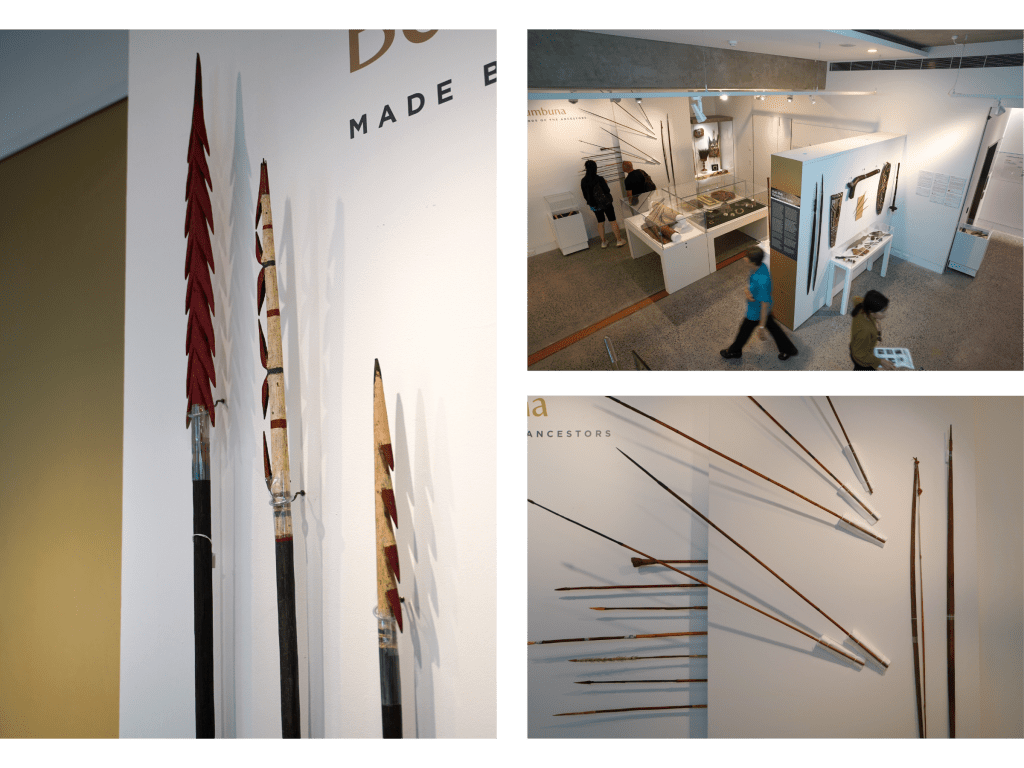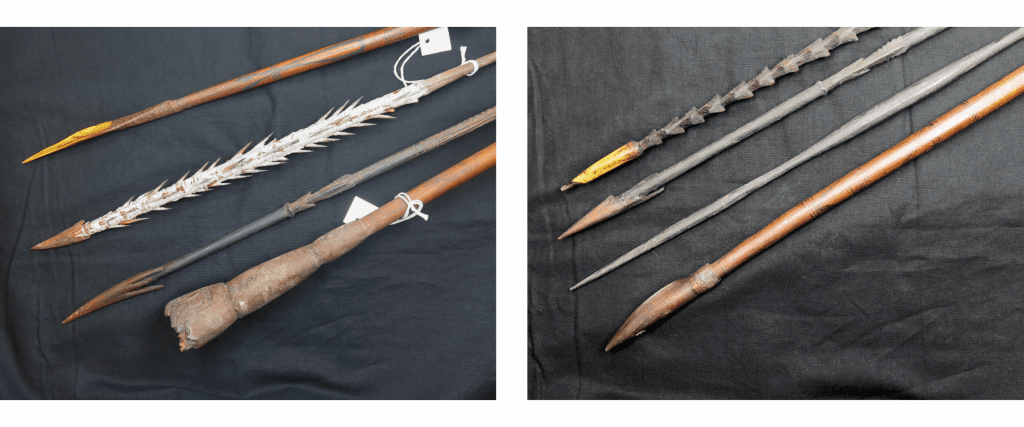Arrows and bows in Han Mak Belong Tumbuna
Until 6 January 2026
A Tok Pisin translation of this story appears below
By: Exhibitions Curator
Step into Han Mak Belong Tumbuna: Made by the Hands of the Ancestors and you will find a display of arrows and bows from the Cairns Historical Society collection. Some arrows are slim reed-shafted tools used for hunting, while others are elaborately carved and decorated. Alongside them are bows of different sizes and forms, each made from carefully chosen materials.
Together, they tell a story of ingenuity, language and tradition in Papua New Guinea.

More than hunting tools
These objects were crafted from carefully selected local materials such as black palm, bamboo and cane, chosen for their strength or flexibility. A black palm bow in the Museum’s collection demonstrates the technical skill required. Such bows were extremely difficult to draw and demanded knowledge of which bamboo species could provide flexibility without brittleness.
Among the arrows are examples with stencilled geometric shafts and woven cane rings. Their barbed black palm heads mark them as more than weapons.
Arrows as cultural markers
In a landmark 1985 study, anthropologist Thelma Bush catalogued 834 Highlands arrows and showed how arrow morphology and decoration mapped onto language groups and regions. The arrows in Han Mak Belong Tumbuna reflect this insight, objects that carried not only utility but also identity.
Other ethnographic work highlights this variety. In West Papua’s Wonie village in 1971, researchers recorded more than thirty arrow types for different game: sung for large mammals, gnalib for medium animals, dupa for birds and waya for fish. These typologies show how arrows were embedded in both ecology and identity.

Regional diversity
Bows also varied across the country. Some mountainous communities near Goroka favoured shorter bamboo bows, while in the Fly and Trans-Fly regions massive two metre bamboo bows were crafted with palm skins. In the Highlands, bamboo-string bows could carry draw weights estimated at 35 to 45 kilograms.
The Cairns collection adds to this broader picture. Alongside everyday hunting equipment are arrows and bows that reflect their ceremonial and symbolic role in Papua New Guinea society.
See them in Cairns
These arrows and bows are more than tools of survival. They are cultural expressions, signatures of place and language and carriers of ritual meaning. Seeing them in Han Mak Belong Tumbuna is a chance to appreciate both their artistry and their stories, and to reflect on the journey ahead as these objects are prepared for re-gifting to their homeland in Papua New Guinea.
Read more about Han Mak Belong Tumbuna
Ol spia na banara long Han Mak i bilong lain Tumbuna
Man Bilong Lukautim Ol Piksa
Go insait long Han Mak Belong Tumbuna, na bai yu lukim ol spia na banara istap long ol samting bilong Cairns Historical Society. Sampela spia em ol liklik ain ol man isave yusim bilong painim abus, na ol narapela em ol bin katim gut na bilasim gut. Klostu long ol igat ol banara i gat kain kain bikpela na kain kain mak, na ol wokim long ol samting ol bin makim gut.
Ol dispela buk stori long pasin bilong wokim ol samting, na tok ples na pasin bilong ol man bilong Papua Niugini.
I no ol tul bilong painim abus tasol
Ol wokim ol dispela samting long ol samting ol bin makim long dispela hap, olsem ol diwai pam, bambu, na stik, na ol makim ol bilong strongim ol na mekim ol samting ino hatwok long en. Wanpela blakpela banara i stap long ol samting bilong Musem kamapim klia olsem ol man igat save long wokim ol dispela samting.
I hatwok tru long wokim ol kain banara olsem, olsem na ol man mas save long wanem kain bambu i save mekim na banara ino save bruk. Sampela bilong ol dispela spia igat piksa bilong ol stik igat ol mak bilong ol samting ol bin wokim long ston na ol ring ol bin wokim long stik.
Ol igat ol liklik han bilong diwai na ol luk olsem ol ino samting bilong pait tasol.
Ol spia istap olsem mak bilong ol samting bilong ples
Long wanpela wok painimaut bilong 1985, saveman Thelma Bush raitim lista bilong 834 spia bilong ol ples maunten na soim olsem wanem ol spia igat ol mak na bilas bilong ol na ol istap long ol grup na ol hap bilong ol tokples.
Ol spia long Han Mak Belong Tumbuna i kamapim klia dispela tingting, em ol samting ino helpim ol man tasol, nogat, ol helpim ol long luksave long ol yet. Ol narapela wok bilong etnografik kamapim klia ol dispela kain samting.
Long Wonie ples long Wes Papua long 1971, ol saveman bin lukim olsem igat winim 30 kain spia bilong ol kain kain abus: sung bilong ol bikpela animal, gnalib bilong ol animal gat bikpela skin, dupa bilong ol pisin, na waya bilong ol pis.
Ol dispela tok piksa soim olsem wanem ol spia insait long ol samting bilong graun na ol samting bilong ol man.
Pasin bilong istap narapela narapela long ol hap
Long olgeta hap bilong kantri igat kain kain kain banara. Sampela ples maunten klostu long Goroka isave wokim ol longpela banara, tasol long hap bilong Fly na Trans-Fly ol isave wokim ol longpela banara long skin bilong diwai pam. Long ol ples maunten, ol banam string isave karim hevi bilong 35 igo inap 45 kilogram. Ol samting ol bungim long Cairns helpim yumi long save long dispela samting. Na tu, ol putim ol spia na banara i stap wantaim ol samting ol man isave yusim long olgeta de bilong painim abus.
Lukim Ol Long Cairns
Ol dispela spia na banara ino helpim ol man long i stap laip tasol. Ol kamapim ol pasin bilong ol man, na ol makim ples na tok ples, na ol kamapim ol pasin bilong lotu. Taim yu lukim ol long Han Mak Belong Tumbuna, dispela opim rot long yu ken save gut long wok bilong ol na long stori bilong ol, na long tingim gen ol samting ol bai mekim taim ol redim ol dispela samting bilong givim long Papua Niugini.

